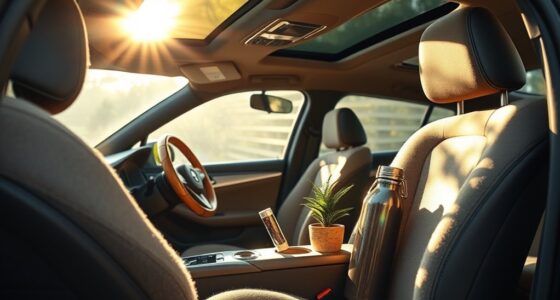A $1000 iPhone isn’t automatically more sustainable just because of its price. Its longevity depends on battery life, repairability, and durability over time. If the battery degrades quickly or repairs are costly and difficult, it may end up harming the environment more than helping. Investing in a device designed for easy maintenance and long-term use can be more eco-friendly. To understand what truly makes a device sustainable, keep exploring the details below.
Key Takeaways
- Higher-priced iPhones often feature durable materials but may have limited repairability, affecting true sustainability.
- Battery longevity and ease of replacement are critical; without these, device lifespan remains uncertain regardless of initial cost.
- Long-lasting devices reduce electronic waste by minimizing frequent upgrades and disposal.
- Complex repairs or costly replacements diminish the environmental benefits of premium smartphones.
- Investing in repairable, easily upgradable tech ensures sustainability beyond initial purchase price.

Is paying more for a $1000 iPhone genuinely a step toward sustainability? That’s what many hope, believing that a higher price tag indicates better quality, longer-lasting components, and a smaller environmental footprint. But the truth isn’t so straightforward. When considering sustainability, two critical factors come into play: battery lifespan and repairability ease. These elements determine whether a device truly stands the test of time or if it’s more likely to be discarded prematurely.
Start with battery lifespan. A longer-lasting battery means your iPhone can operate efficiently for years, reducing the need for frequent replacements. Apple has made improvements here, claiming their newer models have better battery longevity. However, even the most advanced batteries degrade over time, losing capacity and performance. When that happens, many users opt to replace their phones rather than just the battery, but this isn’t always straightforward. If the battery isn’t designed for easy replacement, you may be forced to buy a new device altogether, negating the supposed sustainability benefits of investing in a premium product. A device with a longer battery lifespan and ease of repair allows you to extend its usability, minimizing electronic waste.
Long-lasting batteries and repairability extend device life, reducing waste and supporting sustainability efforts.
Repairability ease is equally essential. A high-priced iPhone might seem durable, but if it’s difficult or costly to repair, it can become more environmentally damaging in the long run. Apple has been criticized for making repairs complicated and expensive, often requiring professional service or proprietary tools. When repairs are accessible and affordable, you’re more likely to fix your device rather than replace it. This means you keep the device longer, reducing waste and conserving resources. Conversely, if the repair process is complex or priced beyond reason, you’re more inclined to dispose of the phone and buy a new one, which contributes to environmental harm. Additionally, the use of natural materials in construction can influence the device’s overall sustainability profile.
Choosing a more sustainable device isn’t just about the initial cost but about the entire lifecycle. A $1000 iPhone might seem like a better investment if it lasts longer or is easier to repair, but only if those features are truly designed with longevity in mind. Otherwise, the higher price tag might not translate into a more eco-friendly choice. Ultimately, the goal should be to select technology that’s built to last, with batteries that retain their capacity and repairability that’s accessible. Only then can paying more genuinely become a step toward sustainability, rather than just a luxury purchase that contributes to the cycle of constant upgrading and waste.
Frequently Asked Questions
How Do Repair Costs Impact the Device’s Overall Sustainability?
Repair costs substantially impact your device’s sustainability because high expenses can discourage repairs, leading to early disposal. When batteries lose longevity and repairs are hard to access or expensive, you’re more likely to replace the device instead of fixing it. Affordable repair options and better battery longevity extend your device’s lifespan, reducing waste and environmental impact. Ultimately, accessible repairs help you make a more sustainable choice with your tech.
What Role Do Software Updates Play in Extending Device Lifespan?
Software updates play a vital role in extending your device’s lifespan by improving battery longevity and enhancing performance. When you install these updates, your phone gets optimized software, which reduces unnecessary battery drain and fixes bugs that could slow down your device. Staying current with updates guarantees your iPhone remains efficient, reliable, and longer-lasting, ultimately helping you get the most value and sustainability from your investment.
Are Recycled Materials Used More in Premium Models?
You’ll find that recycled materials are more often used in premium models to enhance recycled content and align with eco-friendly trends. Manufacturers tend to incorporate these sustainable materials into devices with premium features to appeal to environmentally conscious consumers. By choosing a high-end model, you support the use of recycled content, which helps reduce waste and minimizes environmental impact, making your purchase more sustainable overall.
How Does Manufacturing Energy Consumption Compare Across Iphone Models?
Did you know that manufacturing an iPhone 13 consumes about 60% less energy than older models? When comparing energy consumption across iPhone models, newer phones tend to be more energy-efficient, reducing their manufacturing footprint. This improvement results from advances in technology and manufacturing processes, making each new model less resource-intensive. So, if you’re concerned about sustainability, choosing newer iPhones can help minimize environmental impact through better energy efficiency.
Do Higher Prices Reflect Better Environmental Practices?
You might think higher prices mean better environmental practices, but luxury branding often influences consumer perception more than sustainability. When you buy a more expensive iPhone, you may believe it’s eco-friendlier, but that’s not always true. Companies sometimes use premium pricing to boost perceived quality or status, not necessarily to improve environmental standards. So, don’t assume that a higher price automatically equals a more sustainable product.
Conclusion
So, next time you’re tempted by that $1000 iPhone, remember that durability matters. If you keep a phone for five years instead of two, you’re reducing waste and environmental impact considerably. For example, a study showed that longer-lasting devices cut e-waste by up to 30%. Ultimately, investing in a more durable phone might cost more upfront, but it’s better for the planet—and your wallet—over time. Choose wisely, and make sustainability your priority.









